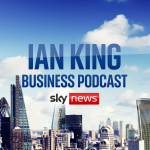There are several very good reasons why shares of Burberry fell by almost 10% at one point this morning on news Marco Gobbetti is stepping down as chief executive.
Firstly, news of his resignation – to become chief executive of Salvatore Ferragamo in his native Italy – was completely unexpected.
Secondly, it is because Mr Gobbetti is regarded as having done a good job.
And thirdly, it is because it has rekindled memories of how Burberry mishandled things when a previous highly-regarded chief executive unexpectedly resigned.
Britain’s only major global luxury fashion group blundered when, in October 2013, the highly regarded Angela Ahrendts announced she was leaving to become head of retail at Apple.
Its response was to name as her successor Christopher Bailey, Burberry’s chief creative officer, a much-respected figure in the world of fashion but a complete unknown as a business leader.
There was much scepticism that Mr Bailey was capable of holding down the roles of both chief executive and chief creative officer and unease among investors was only heightened by a peculiar corporate video in which Ms Ahrendts said she had “such peace being able to exit stage left…with Christopher at the helm, leading, dreaming”.
The mood among investors was not helped when, the following spring, it emerged that Mr Bailey had been awarded a “golden hello” in the form of £7.6m worth of shares on becoming chief executive.
This was on top of a retention bonus worth some £15m that he had been given the previous summer.
Neither of these share awards were subject to any conditions or performance targets.
The ire of shareholders was also raised by news that he had, controversially, also been awarded a £440,000 “annual allowance” that the company made little attempt to explain but which was interpreted by some in the media as a clothing allowance.
More than half of Burberry’s shareholders voted against the awards – the vote was non-binding – at the Burberry annual meeting in July 2014.
The mood did not improve when, just weeks later, Mr Bailey sold some £5.2m worth of shares.
The unease rumbled on when in June 2016 it was announced that John Smith, Burberry’s highly-regarded chief operating officer and the man presented to investors as the person focused on the bottom line while Mr Bailey concentrated on hemlines, was leaving.
The pressure finally told when, the following month, Burberry announced that Mr Bailey would be replaced by Mr Gobbetti as chief executive but would be retaining the role of chief creative officer and had been handed a new title, president, which obviated the need for him to take a pay cut.
He was also handed another £10.6m worth of shares to cushion the blow.
It was, however, an admission from Burberry that the experiment had failed and that Mr Bailey’s appointment had been little short of a disaster.
Shares of Burberry, which had been 1490p when Mr Bailey’s appointment was announced, had fallen to just 1175p by the time it was announced he was stepping down.
Mr Gobbetti, who had been hired from the French luxury brand Celine, where he had been chairman and chief executive, quickly steadied the ship on finally taking the helm in July 2017.
Within months, Mr Gobbetti – renowned for growing and developing Givenchy, Moschino and Bottega Veneta – had unveiled a turnaround strategy, at the heart of which was taking Burberry further into the luxury end of the fashion market to compete more directly with the likes of Gucci and Louis Vuitton.
Burberry goods would henceforth no longer be sold to wholesalers and retailers in the non-luxury sector, particularly mass market US retail outlets, and production of luxury leather handbags stepped up.
The company bought one of its Italian leather goods suppliers to effectively take production in-house.
Another decision Mr Gobbetti had to make early on in his tenure was coming up with a replacement for Mr Bailey, who stepped down as chief creative officer at the beginning of 2018.
He alighted on Riccardo Tisci, a fellow Italian, with whom he had worked successfully at Givenchy.
At around the same time, Gavin Haig, former chief executive of the luxury group Belstaff, was hired to a newly-created post of chief commercial officer.
Burberry also started to take a more imaginative approach to e-commerce by, for example, making its entire range available on the luxury online fashion platform Farfetch.
It signed deals with other partners such as the Chinese entertainment and technology giant Tencent.
As important was another announcement to highlight the changes taking place at the company.
During Mr Bailey’s time as chief executive, Burberry was embarrassed by revelations that it had been burning unsold stock for years, in spite of its apparent support for sustainable fashion causes.
Mr Gobbetti announced in September 2018 that it would no longer do this and, at the same time, said it would no longer use real fur.
Progress was encouraging.
Burberry’s sales and operating profits began to recover, in spite of headwinds such as unrest in Hong Kong, which disrupted retail activity in one of the company’s most important markets.
Mr Tisci’s new ranges were well received and, by early 2020, Mr Gobbetti was sounding increasingly confident.
Then came COVID-19.
Retail ground to a halt in much of the world and so did international travel and duty free sales.
Burberry, with its strong position in Hong Kong and China, was among the first to warn of the malign impact of the pandemic.
For the year to the end of March 2021, sales fell by 11% and earnings by 14%.
Despite that, unveiling the results in May, Mr Gobbetti told investors: “We wanted to re-energise our brand, renew our product, evolve our communications and transform the customer experience.
“We also set out to maintain sales and profit broadly stable while undergoing this transition.
“And I’m pleased to say that in the last three years, we achieved what we set out to do and transformed our business.”
Those comments, today, read as if Mr Gobbetti already knew he was about to return to Italy.
So it is no surprise that investors are uneasy at his departure.
Burberry was at a low ebb when, in July 2016, Mr Gobbetti was named chief executive.
He has restored its fortunes.
Not immediately obvious, though, is whether he has set in train a longer-term path to sustainable growth or simply stopped the rot that set in under Mr Bailey.






















